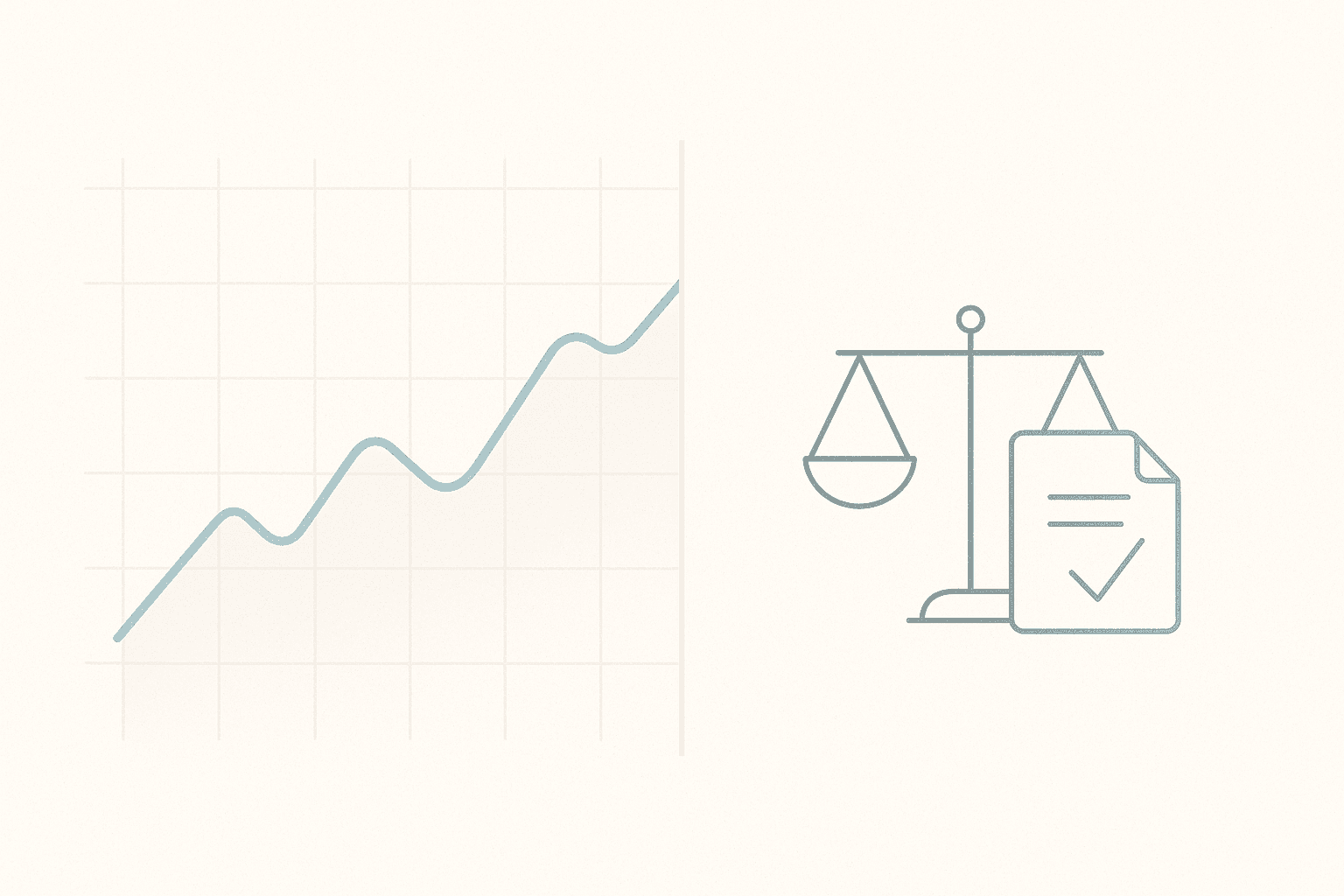AI Lawyer Blog
CCPA Privacy Notice Template (Free Download + AI Generator)

Greg Mitchell | Legal consultant at AI Lawyer
3
A CCPA Privacy Notice explains how your business collects, uses, shares, and sells (or does not sell) personal information of California residents, and it tells people how to exercise their rights. It must be easy to find, written in clear language, and aligned with current California law (CCPA as amended by the CPRA).
California’s population is about 39.4 million, so if your product touches the U.S. market, chances are high you reach Californians and need a compliant notice. Regulators have also stepped up enforcement: the California Privacy Protection Agency announced a $1.35 million CCPA settlement in September 2025, and the Attorney General’s office previously obtained $1.2 million in the Sephora case, signals that notices and practices must match the law.
Download the free CCPA Privacy Notice Template or customize one with our AI Generator, then have a local attorney review before you sign.
You Might Also Like:
Cloud Service Agreement Template (Free Download + AI Generator)
Catering Services Agreement Template (Free Download + AI Generator)
1. What Is a CCPA Privacy Notice?
A CCPA Privacy Notice is the publicly available statement that tells California consumers what personal information you collect, why you collect it, how you use and share it, and how people can exercise their rights. The notice typically appears at or before the point of collection (web forms, app screens) and as a dedicated webpage. It must include disclosures on categories collected, retention, purposes, selling/sharing, sensitive data, and how to submit requests.
The notice is not a marketing page; it’s a compliance document. It should track your real data flows, your vendor contracts, and your internal retention rules. If your practices change, the notice must be updated promptly to avoid misleading consumers or regulators.
2. Why a CCPA Privacy Notice Matters in 2025?
California privacy law now has both the Attorney General and the California Privacy Protection Agency enforcing compliance. CPRA amendments took effect on January 1, 2023, and CPPA regulations are in force — so notices that still mirror pre-CPRA language are risky.
Beyond enforcement, clear notices reduce consumer complaints, streamline customer support, and improve trust. They also help harmonize with other regimes (e.g., GDPR, UK GDPR) by documenting categories, purposes, and rights in one place. Finally, a correct notice makes DSAR response faster because request handlers can follow the exact categories and retention listed.
3. Key Sections and Components
Scope: Identify who the notice covers (consumers, applicants, employees) and where it applies (website, app, offline collection).
Categories of Personal Information: Map to CCPA definitions (identifiers, commercial info, internet activity, geolocation, inferences, etc.).
Sources and Purposes: State main sources (user, devices, data brokers) and purposes (provide services, security, analytics, marketing).
Retention Periods: Explain how long you keep each category and the criteria used (legal, security, business need).
Selling/Sharing Disclosures: Say whether you sell or share data for cross-context behavioral advertising and how to opt out.
Rights and How to Exercise Them: Describe access, deletion, correction, portability, opt-out of sale/share, and limit use of sensitive PI.
Sensitive Personal Information: Identify sensitive categories and any limited uses.
Methods for Requests: Provide at least two methods where required (webform, toll-free number, email).
Verification and Appeals: Explain identity verification and any appeal process.
Children’s Data: Address under-16 opt-in where applicable.
4. Applicability and Thresholds
Not every business is covered, but many are. CCPA applies to for-profit entities doing business in California that meet thresholds (e.g., revenue, data volumes, or selling/sharing PI). If you’re covered, CPRA amendments and CPPA regulations now apply, your notice must reflect them. The California DOJ’s CCPA page confirms the CPRA amendments are in effect and must be followed.
If you’re unsure, audit your California ties: revenue, online traffic, device telemetry, and data sales/sharing. When in doubt, align your main privacy notice to CCPA standards and use just-in-time notices at collection points.
5. How to Customize Your Notice
Audience: Create role-specific addenda (consumers, employees/applicants, B2B contacts) to avoid mixing rights that differ by audience.
Data Mapping: Use your inventory to list each category you collect and the purposes — avoid boilerplate that doesn’t match reality.
Opt-Out Mechanisms: Implement “Do Not Sell or Share My Personal Information” links and honor Global Privacy Control (GPC) signals where required. The AG’s Sephora action highlighted failure to process GPC as a violation.
Vendors: Update service-provider/contractor disclosures to match your contracts and technical signals (cookie tools, SDKs).
Localization: Translate and adjust for readability where you serve multilingual audiences.
6. Step-by-Step Guide to Drafting It
Step 1-Map data categories: Align your real data flows with CCPA categories; confirm sources and purposes for each.
Step 2-Confirm selling/sharing status: Determine whether activities constitute “sale” or “share” and document opt-out processes.
Step 3-Define retention: Set retention by category and legal basis; avoid indefinite retention without justification.
Step 4-Build rights instructions: Write plain-language steps for access, deletion, correction, portability, and limit-sensitive-PI requests.
Step 5-Add request methods: Provide at least two methods where required and a clear verification flow.
Step 6-Address minors: Insert under-16 opt-in rules and parental consent processes if needed.
Step 7-Review cookies/SDKs: Ensure the notice matches your actual tags, pixels, and app SDKs; sync with your cookie banner.
Step 8-Test GPC handling: Verify browser global privacy controls are detected and honored.
Step 9-Legal and security review: Have privacy counsel and security review the final draft for accuracy.
Step 10-Publish and monitor: Post prominently, date-stamp, and set a cadence for reviews after product or vendor changes.
7. Tips for Compliance and Clarity
Write for humans: Short sentences and layered design help people find key rights quickly.
Match practice to paper: Your notice should mirror actual processing and contracts — misalignment is what triggers enforcement.
Surface opt-outs: Place “Do Not Sell or Share” and “Limit Use of Sensitive PI” where people expect to find them.
Honor signals: Implement and test GPC handling regularly.
Keep records: Log requests, response times, verification steps, and outcomes for audit readiness.
Train teams: Ensure support and engineering know what the notice promises — especially timelines and verification.
8. Checklist Before Publishing
Audience and scope are clearly defined.
All collected categories are listed with sources and purposes.
Retention time frames or criteria are stated for each category.
Selling/sharing status is accurate with working opt-outs and GPC.
Two or more request methods are live and tested.
Sensitive PI use and limits are disclosed.
Minors’ rules and consent paths are included if applicable.
Date of last update and contact information are present.
Download the Full Checklist Here
9. Common Mistakes to Avoid
Using generic boilerplate: Copy-paste notices that don’t match your data map invite complaints.
Forgetting GPC: Ignoring global privacy control signals has already led to enforcement.
Hiding opt-outs: Burying “Do Not Sell or Share” in footers frustrates users and regulators.
No retention detail: Saying “we retain as long as necessary” without criteria is too vague.
Inconsistent vendor signals: Cookies/SDKs that sell/share while your notice says you don’t.
Failing to update: Product and vendor changes should trigger notice updates.
10. FAQs
Q: Do I need a separate CCPA notice if I already have a general privacy policy?
A: Often yes. Many companies maintain a main privacy policy and a CCPA-specific notice or section that clearly addresses California rights and definitions. Consolidation is possible if the combined document satisfies CCPA content and placement rules. What matters is that Californians can easily find, understand, and use their rights as described in the law and regulations.
Q: How do I know if my activity counts as “selling” or “sharing” personal information?
A: Review your data disclosures to ad tech, analytics, and affiliates. “Sale” can include exchanges for valuable consideration; “share” covers cross-context behavioral ads. Examine contracts, tags, and SDK behavior — not just internal intentions. If in doubt, provide opt-outs and ensure the technical pathway (including GPC) works as advertised.
Q: What methods must I provide for consumer requests?
A: The law requires at least two designated methods in many cases (for example, a toll-free number and a webform). Methods must be easy to use, and you should explain verification steps. For online-only businesses, web-based methods can suffice, but be sure to meet identity verification and response-time requirements in your workflows.
Q: How often should I review or update the notice?
A: Update whenever your data practices, vendors, categories, retention, or selling/sharing status change. Many organizations schedule quarterly or release-based reviews. Keep an audit log of changes and republish the “last updated” date. Training teams to flag changes is just as important as the review cadence itself.
Q: What enforcement trends should we keep in mind?
A: California regulators have demonstrated willingness to pursue settlements and public actions over failures to honor opt-outs and GPC or to provide compliant notices. The $1.35 million CPPA settlement in 2025 and the $1.2 million Sephora case show the direction of travel: align your notice with real practices and verify the tech pathways regularly.
Sources and References
California enforcement and regulatory data cited in this article reference the California Privacy Protection Agency (CPPA) enforcement updates including the 2025 $1.35 million settlement, and the California Department of Justice (DOJ) Sephora enforcement action reporting a $1.2 million penalty.
Legal definitions and compliance requirements are drawn from the California Consumer Privacy Act (CCPA), Cal. Civ. Code §§ 1798.100 et seq. as amended by the California Privacy Rights Act (CPRA).
Additional guidance and interpretive materials align with the CPPA Regulations, the California Attorney General’s CCPA FAQs, and the U.S. Federal Trade Commission (FTC) privacy transparency principles.
Disclaimer
This article is for informational purposes only and does not constitute legal advice. Privacy laws and regulations change frequently and vary by jurisdiction. Always consult qualified counsel before drafting, publishing, or relying on a CCPA Privacy Notice.
Get Started Today!
A clear, accurate CCPA Privacy Notice protects consumers and reduces regulatory risk. Map your data, match your notice to reality, and keep opt-out signals working.
Download the free CCPA Privacy Notice Template or customize one with our AI Generator, then have a local attorney review before you sign.
You Might Also Like:



